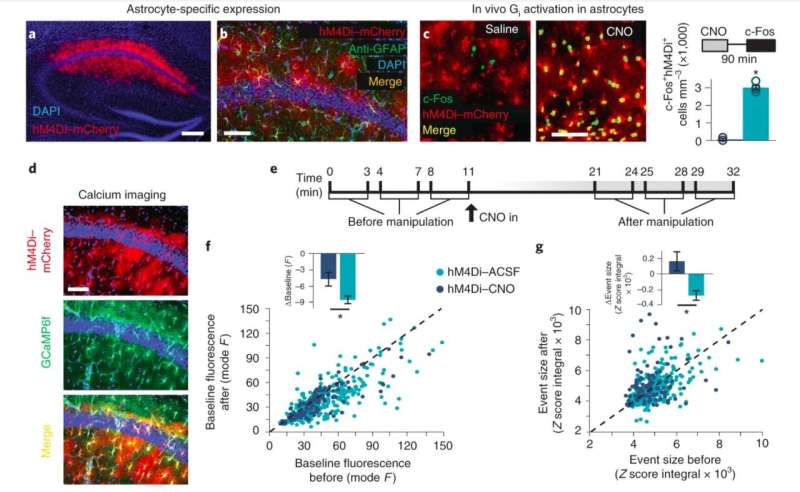September 8, 2020 feature
Study highlights the role of astrocytes in the formation of remote memories

Memories from a distant past, also known as remote memories, can guide the present and future behavior of humans and other living organisms on Earth. In psychology and neuroscience, the term "remote memories" refers to all memories related to events that took place from a few weeks to decades in the past.
Many past studies have explored the neural underpinnings of remote memories or tried to identify brain regions that could be involved in how they are formed and maintained over time. So far, most findings have suggested that the interaction between the hippocampus and frontal cortical brain regions plays a key role in the consolidation of these memories.
Past observations suggest that the interaction between these brain regions changes as time goes by and as memories go from being recent (i.e., a few years old) to remote. The exact time when these brain regions become involved in the formation of a memory and for how long they remain important to its endurance, however, is still poorly understood.
Astrocytes are star-shaped cells that are known to have several functions, including the regulation of the metabolism, detoxification, tissue repair and providing nutrients to neurons. Recent studies have found that these cells can also change synaptic activity in the brain, thus impacting neuronal circuits at multiple levels.
Researchers at the Hebrew University of Jerusalem have recently carried out a study aimed at exploring the role of astrocytes in memory acquisition. In their paper, published in Nature Neuroscience, they present a number of new observations that shed light on the unique contribution of these cells in enabling the formation of remote memories in mice, and potentially also humans.
To investigate the role of astrocytes in memory formation, the researchers used a series of chemogenetic and optogenetic techniques. These techniques allow neuroscientists to manipulate astrocytes and other types of brain cells in reversible ways and to observe an animal's behavior when specific cell populations are active or inactive.
In their study, the researchers used them to activate specific designer receptor pathways in astrocytes within the mouse brain. They then observed the effects of this activation on the animals' behavior and on their ability to form memories.
"We expressed the Gi-coupled designer receptor hM4Di in CA1 astrocytes and discovered that astrocytic manipulation during learning specifically impaired remote, but not recent, memory recall and decreased activity in the anterior cingulate cortex (ACC) during retrieval," the researchers wrote in their paper.
The new findings represent a significant step forward in the understanding of astrocytes and their unique functions. Overall, they provide further evidence that astrocytes can shape neuronal networks in intricate ways and affect many cognitive functions, including the acquisition of remote memories.
More specifically, the researchers observed that when a mouse was acquiring a new memory, ACC-projecting CA1 neurons were recruited in large numbers and neurons in the anterior cingulate cortex (ACC) were simultaneously activated. When they activated Gi pathways in astrocytes using chemogenetic techniques, however, the communication between CA3 and CA1 neurons was disturbed, which prevented activation in the ACC.
As a result of their intervention on astrocytes, the projection typically observed between CA1 and ACC neurons in a mouse brain as the animal is learning something was repressed. This, in turn, appeared to impair the mice's ability to acquire remote memories.
The findings suggest that astrocytes play an important role in the formation of remote memories in mice and potentially humans, via their ability to regulate the projection of neurons onto other areas of the brain. In this particular instance, they may control the communication between CA1 neurons and the ACC, which seems to be essential for remote memory formation.
"We revealed another capacity of astrocytes: They affect their neighboring neurons based on their projection target," the researchers concluded in their paper. "This finding further expands the repertoire of sophisticated ways by which astrocytes shape neuronal networks and consequently high cognitive function."
More information: Adi Kol et al. Astrocytes contribute to remote memory formation by modulating hippocampal–cortical communication during learning, Nature Neuroscience (2020). DOI: 10.1038/s41593-020-0679-6
© 2020 Science X Network


















